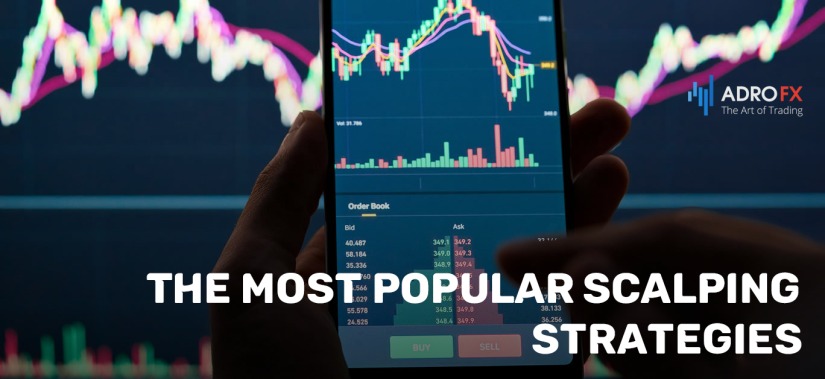What is Scalping Trading? Beginner's Guide & Tips

Every trader has at least once heard of aggressive intraday trading when numerous trades are placed during a trading session. Such a trading style is called scalping.
Today we will learn what scalping is, how trading using this method works, and what its advantages and risks are.
What Is Scalping in Plain Language?
Scalping is a kind of speculative intraday trading strategy based on opening many short-term trades to get a small return on them and sum up the expected rate of return.
In simple words, scalping is intraday trading with a lot of tiny returns on each order to get a significant total gain.
Many people call scalping a trading strategy, but it is not quite right - in fact, scalping combines many trading strategies with the common feature - of quick opening and closing of the positions.
Among traders, scalping is one of the highly beneficial but very complex trading strategies requiring a lot of discipline and experience. There are two contradictory points of view.
The first one considers that scalpers are traders who have to spend time at the monitor with the trading terminal 24 hours a day.
The second one describes scalpers as traders with a lot of free time who trade just 1-2 hours a day and leave the market.
The truth, as always, is somewhere nearby. The supposed one-hour trading can take a whole day, and short trades are not without stress, after which it takes a lot of time to recover.
Scalping Rules, Basic Requirements, and Tools
Small "price jumps" constantly occur in the high-liquid markets, so one can enter the market plenty of times during the trading session.
Collecting small gains on each trade, the trader finally obtains a higher total return, and correctly setting the limitation of losses does not allow the position to fall into the red zone.
Obviously, the best variant of such trading is in volatile markets, where Ask and Bid are close to each other, and there are no problems with entering/exiting a position.
For fast trades theoretically, any section of the financial market is suitable, however, because of the size of commissions, as well as the level of liquidity, they are most often concluded on the futures and currency market. Trading in the futures market - gold futures, oil futures, and stock indexes; volatile currency pairs would be suitable.
Scalping in the stock market is uncomfortable because of the need to pay deposit fees as well as the relatively low volatility.
Derivative financial instruments such as blue-chip stocks futures or indices are highly liquid and have sufficient volatility, yet they offer the possibility of leveraged trading, which is very convenient for trades aimed at a gain of 4-5 points.
As a rule, a wide range of tools and means of technical analysis are used in scalping strategies for defining market entry.
There are well-known MACD, RSI, Alligator, and Heikin Ashi as well as some specialized indicators.
Very often a trading system is based on the signals of two or three means of technical analysis.
Almost all scalping strategies allow limiting the risks. The classical variant is the risk/reward ratio of 1 to 3. The easiest way, in this case, will be setting the Stop Loss 3 points lower and Take Profit 9 points higher than the opening price.
Some trading systems of such kind allow trading only at a certain time of day (night scalping) or in a certain price direction (trendy, channel scalping).
Many traders use automatic scripts in trading, which allow them to place an order with preset parameters (lot size, Stop Loss, and Take Profit) by dragging them to a chart or by pressing one key.
Automated trading systems are widely used by scalpers. Their advantage, in this case, is obvious. Trading in manual mode, especially scalping, involves a lot of stress and worry, sometimes the trader is in a state of tilt.
Automated Expert Advisor is devoid of emotions and works strictly according to the algorithm, which in this case, is extremely important.
The Most Popular Scalping Strategies

As we have already mentioned, scalping implies not one but many different trading strategies. Let us have a look at the most popular ones.
Two Moving Averages
This is a simple but reliable scalping trading system with few instruments. When trading, Simple Moving Averages (MAs), with periods: 20 and 10, are used.
The essence of the strategy is quite original - the position opening is carried out at a divergence of the two MA lines (usually the signal to enter the market on the contrary is the intersection of MA lines). Trading takes place in the time frame M5, and the key rule is not to keep the position open for more than 1 hour.
The following conditions serve as a signal for opening a long position:
- Both divergent MA lines are directed upwards;
- The price curve has rebounded from the 20-period MA and broken out the upper line of MA 10.
The short position is opened in the other case, when:
Both diverging MA lines are directed downward;
- The price curve will rebound from the 20-period MA and break the bottom line of MA 10.
Take Profit and Stop Loss are set at a distance of 10-15 points from the market entry point.
The main advantages of the strategy are its simplicity and the low number of false signals.
MOMO
The strategy is based on two well-known indicators: MACD and EMA with a period of 20. The system is suitable for most volatile assets.
Trading is done in the M5 time frame. When the MACD crosses the zero line, and the EMA crosses the price curve from bottom to top, the trader waits for the curve to move away from the MA by 10 points and opens a buy order.
Again, when the MACD crosses the zero line, and the price chart goes through the EMA from top to bottom, after waiting for the price to move 10 points away from the MA, the trader should open a short position
When placing orders according to this trading system, the limitation of losses is obligatory. Stop Loss can be placed at the level of 3-5 points from the lot buy/sell price. Take Profit is set at a distance of 7-10 points.
Impulse Scalper
This trading method is based on the theory that all markets are interconnected and, therefore, it uses the behavior of other instruments such as foreign indexes, commodity market assets, currency rates, etc. as indicators.
Thus, the trader follows not only the chart of the traded asset but also one or several "guides" - assets with which the scalper believes that the asset being traded correlates.
Hybrid Scalping
This one combines strategies that take into account both the correlation of different assets and information about the number of transactions in the order book. They involve a larger volume of analysis, but also consider more factors affecting the dynamics of quotes.
Often scalpers observe the behavior of the instrument in graphical patterns, opening positions during the formation of the most distinctive of them - this method also helps to increase the efficiency of trading. Even though it is not recommended to trade upon the patterns in classic intraday strategies, in the case of scalping it may be beneficial enough.
In addition, some strategies allow traders to work both in case of a trend and in case of relatively small oscillations and sideways movement. Often, scalpers trade in the formed "corridor" - when the price in a sideways or small upward or downward movement forms levels that can be graphically marked.
What Should You Do If There Is A Drawdown on The Account?
Before we start looking at the question, it should be noted that almost every scalping strategy has a cornerstone rule of compulsory Stop Loss setting. A professional scalper does not think about possible losses when trading. He is fully focused on finding the "right" point to enter the market.
If for some reason, the loss limit is not set or the price has jumped over it, the trader is advised to close the position immediately. The strategy where an open position "hangs" because of a loss at least ceases to be a scalping strategy and leads to the loss of the entire deposit.
An even more difficult market situation is represented by a series of losing trades. There are times on the markets when even the most effective trading systems stop working. Orders are closed with "negative" return time after time, and the trader wants to win back the loss at any cost. However, in this situation, the best decision for the scalper is to close all trades and stop trading.
Scalping is a high-risk speculative type of trading. That is why it is necessary to learn to patiently wait out non-standard market situations.
How Much Can You Make From Scalping?
From the many definitions, we can conclude that this is a highly beneficial type of trading. The use of such a strategy may well double the deposit in a trading session. According to the developers of scalping EAs, the back-tests of these trading systems in certain time intervals show returns of 1000% and 3000% per annum.
At the same time, it should be understood that the yield for a single time interval does not guarantee a constant result. It is also necessary to note that the complexity of trading and the high requirements for the professionalism of a trader reduces the probability of organization of work according to all rules of such trading systems. In simple words, it will be extremely difficult for most traders to organize trading correctly.
The ratio of financial success of a trading system to the initial investment is a separate variant of efficiency estimation.
Scalping strategies have several peculiarities which should be understood. Most trading systems are tested on small deposits. In recommendations of authors of strategies and developers of Expert Advisors, the sums of $100-200 are often mentioned, while the work is performed with the use of rather big leverage. Taken together, all this gives a high percentage of lucrativeness, in case of successful market conditions and the correct realization of a strategy.
At the same time, when trading large lots such phenomena as slippage is possible. It will not let a trader enter and exit a trade at the proper time.
The Risks of Scalping Strategies
Scalping, as well as any work with the financial market, carries certain difficulties and risks. They must be controlled to successfully trade financial instruments and receive yield from them. The most serious problems for a scalper are:
- Psychological. Permanent control and analysis exhaust you not only physically, but also mentally. In addition, as the total number of trades increases, so does the number of those that are closed with a loss. Since losses are an integral part of trading, many traders are ready for it, but not everyone can adequately accept 50 losing trades per day, especially, if they occur in a row. Tilt during scalping is much more dangerous because losing control immediately will cause new losses and further aggravation of this condition. To avoid this, you must have nerves of iron.
- High risk.Since, for scalper trading, the opening and closing trades are counted in seconds, stop orders cannot always be used adequately, especially if the trader trades manually. For this reason, nothing ensures the scalper against a serious movement of quotes against the position, the losses from which can be many times greater than the planned return. Nowadays, there are quite a lot of applications facilitating scalping, and some of them have a function for the rapid setting of stop orders, but the best programs for this purpose cost a lot of finances. For this reason, the skill of quickly limiting your losses is also important.
- Technical risks. Scalper's trades are much more sensitive to command lags, so a two-second internet freeze can cost a trader a lot of funds.
Advantages and Disadvantages of Scalping Trading
Scalping has several significant advantages over other methods of forex trading. The main ones include:
High earnings potential. As practice shows, it is scalpers who get the highest return within a limited period among all traders. One of the reasons for this is the practically complete absence of initially successful trades, which leads to loss because even small gains are fixed practically at once.
A small volume of investments. Very solid sums of cash are necessary for passive and long-term investments, otherwise, their earnings will be ridiculous. Scalping allows you to trade with a couple of hundred dollars and be quite serious about capitalizing that would require several thousand for long-term investors.
Low risk per single trade. The small volume of investments also reduces the risk of high losses from a single trade. Besides, most scalping strategies allow fixing losses at their minimum values.
Numerous entry points. Since small fluctuations are much more frequent than large ones, there is no need for a scalper to sit outside the market waiting for the very same signal - they can open a position practically at any time with acceptable asset volatility.
Possibility of automation. Scalping provides an opportunity to develop a purely mechanical strategy that in the future can be automated with a trading robot.
However, we can also highlight a few significant disadvantages that should be considered when choosing a trading strategy.
Risk/reward ratio. Because of the speed at which trades are executed, the ratio of Take Profit to Stop Loss in scalping is usually at or slightly above 1:1, while the normal value for medium-term strategies is 1:3 to 1:9. Therefore, the percentage of successful trades should be higher in scalping to maintain positive return.
Time. Scalping takes much more trader's time than medium-term trading or long-term trading. However, it should be noted that it is associated with the corresponding experience.
Commissions. Because of a large number of trades, commissions, especially for a poor choice of broker, can eat up to one-third of the gain attained by a scalper, while in the case of a longer-term trading method the amount of commission charged is practically imperceptible against the background of earnings.
It should be understood that if you choose to start scalping, there is a chance of wiping out all the returns made during the day on small movements with a single trade.

Tips For Scalping Trading
There are several quite obvious recommendations that novice scalpers often do not follow, and as a result, they do not get the results they expected. Those include the following tips:
- Do not overwork. Fatigue leads to concentration disorders, and this leads to losing trades. As soon as the trader feels that they're not in the best shape today, trading should be stopped immediately.
- Trade at a convenient time. You should not try to place order by order all day long - it is better to choose the periods when the asset price behavior is most favorable for trading using some scalping strategy.
- The right broker. When choosing a financial intermediary, you should pay attention to its commission rates and availability of separate price lists for scalping trades - this can significantly increase the final return because prices at different brokers can differ several times.
- Trading assets. You should not use a popular or well-known financial asset. It is better to use for scalping those instruments, the causes, and variants of price movement which are really clear to you.
- Discipline. Scalping may seem easy, but it is very important to be disciplined because scalping is often treated as a game of chance where the focus is not on a strategy but on faith in luck. Of course, this approach does not end well - you need to strictly adhere to your trading strategy to achieve good results.
Summary
Having considered the possibilities of scalping strategies, we can come to several conclusions.
Scalping is a complex speculative trading system that can be correctly implemented only by experienced traders.
Also, scalping is not suitable for trading with large deposits because in this case, the efficiency of the system will naturally decrease (that is why serious market players do not use this method).
As we can see, the applicability of scalping trading systems is limited. However, it is interesting that a trading system can be used for the "acceleration" of the deposit. In other words, having a deposit of $100, a trader can quickly increase it to $1000-2000 and then switch to another trading system.
In addition, scalper theoretically can withdraw their earnings regularly leaving the optimal amount for work on the deposit. However, the complexity of scalping trading systems, in this case, makes the regularity of receiving such gain questionable.
Scalper's skills are considered to be the highest mastery among traders because it requires high concentration, the ability to analyze quickly, and a large time investment. However, the potential return of scalping is quite capable of recouping the investment in its full-fledged mastering.
About AdroFx
Established in 2018, AdroFx is known for its high technology and its ability to deliver high-quality brokerage services in more than 200 countries around the world. AdroFx makes every effort to keep its customers satisfied and to meet all the trading needs of any trader. With the five types of trading accounts, we have all it takes to fit any traders` needs and styles. The company provides access to 115+ trading instruments, including currencies, metals, stocks, and cryptocurrencies, which make it possible to make the most out of trading on the financial markets. Considering all the above, AdroFx is the perfect variant for anyone who doesn't settle for less than the best.









